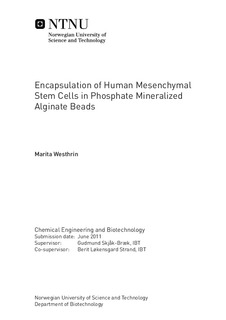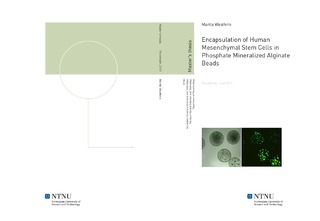| dc.description.abstract | Alginate scaffolds show good promise for bone tissue engineering using stem cells. This is due to the fact that alginate is biocompatible, non-immunogenic, and in addition may direct differentiation of stem cells into a given phenotype. Finally, due to their ability to gel at physiological conditions, living and functional tissue are easily encapsulated into alginate beads. Alginate beads can be modified in a range of ways, not only to enhance the matrix stiffness and stability, but also to promote cell adhesion and direct differentiation towards a given phenotype. A method currently used to encourage bone growth is to mineralize the alginate beads, thus mimicking the structure of bone in vivo. Recently, Xie et al. (2011) demonstrated that enzymatic mineralization of alginate beads serves as a potent method for mineralizing beads as lower concentrations of CaCl2 is needed, which is beneficial for cell viability. In addition, the enzymatic method produces alginate beads with a uniformly distribution of calcium phosphate (CP) and stiffer mechanical properties. Mesenchymal Stem cells (MSCs) have the potential to differentiate into a variety of tissues, including cartilage, adipose, muscle and bone. MSCs extracted from bone marrow seem to possess the greatest potential for bone tissue engineering, as they are more easily differentiated into osteogenic phenotypes when compared with MSCs from e.g. adipose tissue. The main objective in the present study was to encapsulate MSCs into alginate beads mineralized with alkaline phosphatase (ALP) and study cell survival, as well as their potential to differentiate into mature osteoblasts inside the beads. To mineralize beads (ALP) was added to the alginate solution, whilst the precursors were added to the growth medium. The mineralization medium was changed every 3 hours (12 hours over night) for the first 2 days post encapsulation.Cell viability was surveyed by live/dead assay and imaging by Confocal Laser Scanning Microscopy (CLSM), and metabolic activity by Alamar Blue (AB) and colorimetric techniques. Examination of cell morphology was accomplished by phalloidin/DRAQ5 staining. Moreover, to investigate cell differentiation, PCR analysis on selected RNA candidates was performed. Quantification of mineral content was accomplished by running Alizarin Red-S (ARS-S) assay. ALP activity was determined using ALP assay. Finally, further investigation of cell- and alginate matrix structure was accomplished using scanning electron microscopy (SEM). To study capsule properties and cell survival, osteosarcoma cells were utilized as model cells. The main objective was to study bead stability, and how the beads and the cells within were affected by the enzymatic mineralization method. Alginate beads proved to be unstable and needed addition of CaCl2 for stabilization purposes. Furthermore, in order to recover cells, citrate was added to the cell/bead suspension. Initially, results were unsatisfactory, as little, or no, RNA was recovered. After optimizing the citrate treatment it was discovered that a sequential method needed to be utilized. Results demonstrated a successful recovery of cells, and RNA of excellent quality.Enzymatic mineralization of alginate beads was found to be a cell friendly way of mineralizing alginate beads. Mineralization of beads was observed in the light microscope, by visual inspection, as well as by SEM. Cell viability remained high when using a concentration of 0.25mg/ml ALP. The osteosarcoma cells proved to be good for optimizing the enzymatic mineralization method, but behaved differently compared with mesenchymal stem cells in terms of viability, and mineralization activity. Furthermore, mineralization of beads by addition of 0.25 mg/mL ALP compared with 0.5mg/mL appeared to be beneficial as image acquisition on CLSM was facilitated and slightly higher viability of cells was observed.In the second part of the present study, human MSCs were encapsulated into alginate beads. After initial experiments the optimal condition for cell survival, and bead stability was determined. Consequently, in the final experiment 16 million MSCs were encapsulated in beads containing 0.25mg/mL ALP, together with a sample without addition of ALP. At day 2 post encapsulation both samples were divided into two batches, one cultured in regular medium, and one in differentiation medium. All samples were stabilized with 7.5 mM of CaCl2.Observations in both light microscope and CLSM revealed that only beads given ALP were mineralized before reaching day 21. At day 21 the sample receiving no ALP, cultured in differentiation medium also appeared mineralized.Mesenchymal stem cells receiving differentiation medium were observed to differentiate into mature osteoblasts in the beads. This was verified by gene expression analysis, cell morphology studies, the presence of collagen in beads seen by SEM and analysis of ALP activity. Metabolic activity measurements confirmed little cell proliferation, nor cell death. However, an increased metabolic activity was observed for encapsulated cells cultured in regular medium relative to cells in differentiation medium. Cell morphology in differentiated samples was recognized by showing elongated actin filaments, compared with the ones cultured in regular medium, which appeared round in shape. The elongated filaments suggest that the cells are able to interact with the alginate matrix and/or minerals. The occurrence of collagen fibers in SEM images further confirmed presence of mature osteoblasts. Samples cultured in regular medium with or without added ALP both showed an increase in osterix expression until day 21 when the study was ended. This was surprising, as it inferred that the alginate matrix itself might influence differentiation of MSCs into osteoblasts, and that the minerals have little effect on differentiation. Runx2 expression was detected in all samples, including unencapsulated hMSCs. The expression of runx2 was at its maximum on day 21, when the study was ended.Encapsulating mesenchymal stem cells into alginate beads mineralized by the enzymatic method is cell friendly, and allows the cells to differentiate into mature osteoblasts when cultured in differentiation medium. Alginate without minerals seems to influence differentiation to a certain extent, suggesting that minerals are not needed for differentiation to occur. The minerals do, nonetheless, speed up the continuing mineralization process. | nb_NO |

